12-14. ruminant/horse/avian digestive phys
1/36
There's no tags or description
Looks like no tags are added yet.
Name | Mastery | Learn | Test | Matching | Spaced |
|---|
No study sessions yet.
37 Terms
microbiota
refers to the community of microogranisms (microbes) in a particular body site or environment
not referring to the genomes present
microbiome
collection of the organisms in the microbiota including the genes encoded in their genomes → implies functional potential of the microbiota
what are functions of the microbiome?
stimulate immune system
decrease pathogen colonization
regulate energy metabolism
produce vitamins (more important in ruminants)
increase energy harvest from diet
how can a host influence their microbiome?
colonization at birth
host genetics, immune system
environment
diet (change substrates provided to microbes)
cellulases
enzymes that hydrolyze beta 1,4 linkages (cellulose)
microbes have these enzymes; mammals do not
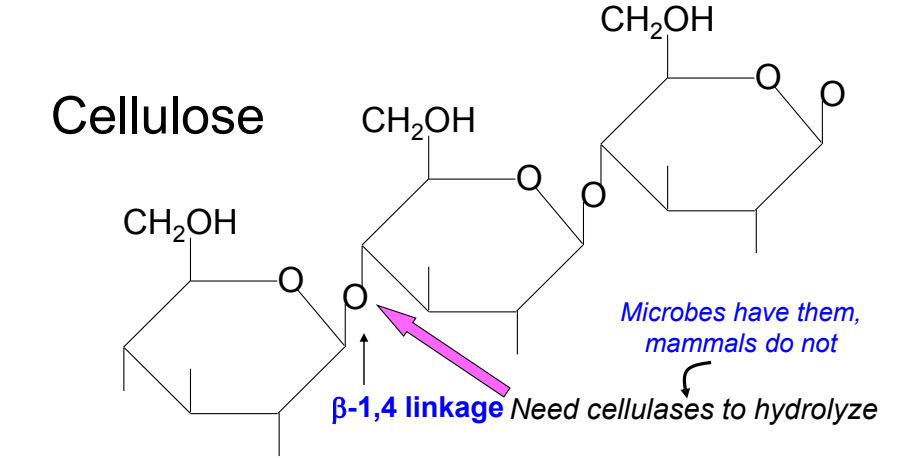
what are some advantages of being a ruminant?
ability to subsist on low quality diets
ability to digest cellulose and other components of plant structural carbohydrates
unique ways of meeting protein needs
microbial lysis provides high value protein to host
recycle their “waste” (urea) for microbial use
get vitamins B and K without having to eat them
made by microbes and are available to host
what are some requirements of the ruminant lifestyle?
requires large time commitment to chewing and ingesting food at regular intervals
nurture rumen population and environment
have metabolic pathways that efficiently utilize volatile fatty acids (VFAs)
less reliance on glucose (microbes consume it first)
ventral layer (liquid zone)
fluid and fine, small particulate ingesta
provides the material that eventually flows out of the rumen/reticulum into the omasum
slurry zone
gradation of particle size from highly fibrous, longer pieces to shorter, denser ones
semi-digested, semi-solid layer
some of this material is ruminated (regurgitated) as the cud bolus
located above ventral layer; below mat layer
mat zone
floating layer of fibrous plant material; contains the most recently ingested food
high densities of microbes
fluid in the mat layer contains salivary constituents and fermentative end products that are gradually being absorbed across the ruminal epithelium
located above the slurry zone
how do the proportions of VFAs produced vary between high fiber and high starch (concentrate) diets?
high fiber diet (↑ roughage)
less VFAs produced overall
produce more methane
greater % of acetate; lower % of propionate
high starch diet (↑ concentrates)
more VFAs produced
produce more lactic acid
lower % of acetate; higher % of propionate
**note: acetate is always produced in the greatest quantities

how is dietary protein digested in ruminants?
some moves to abomasum/small intestine for digestion & absorption
bacterial proteases break dietary proteins down into peptides
peptides are absorbed into bacteria where peptidases break them down further into amino acids
amino acids have two fates:
used by microbes for growth
deamination
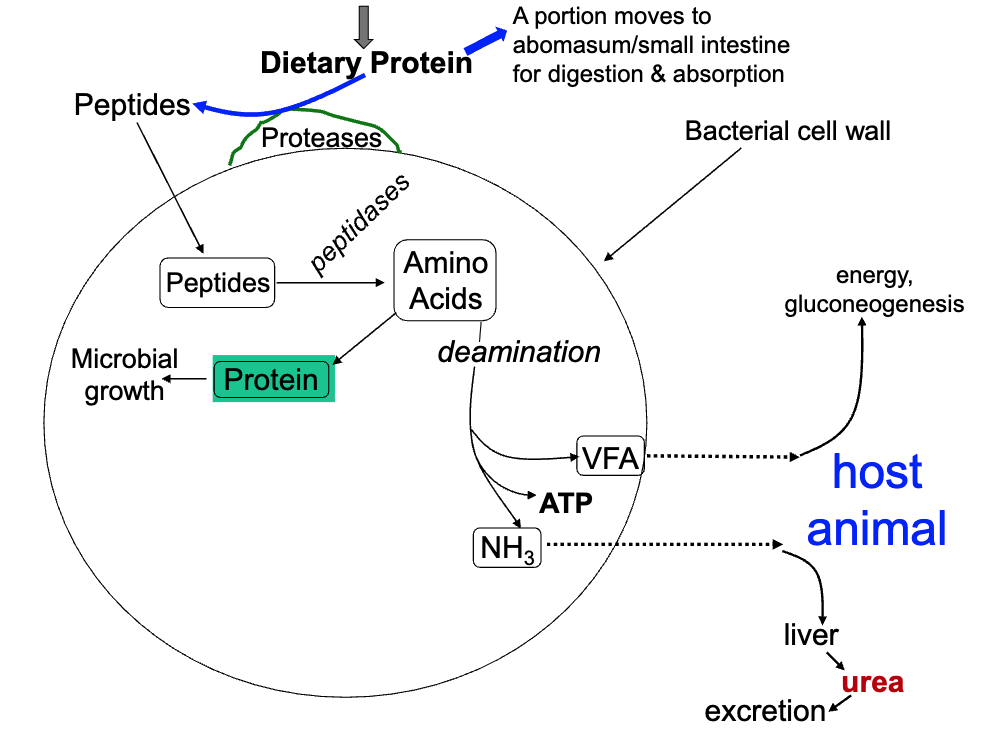
what are the products of amino acid deamination?
VFAs → can be used by host animal for energy/gluconeogenesis
ATP
NH3 → converted to urea in the liver
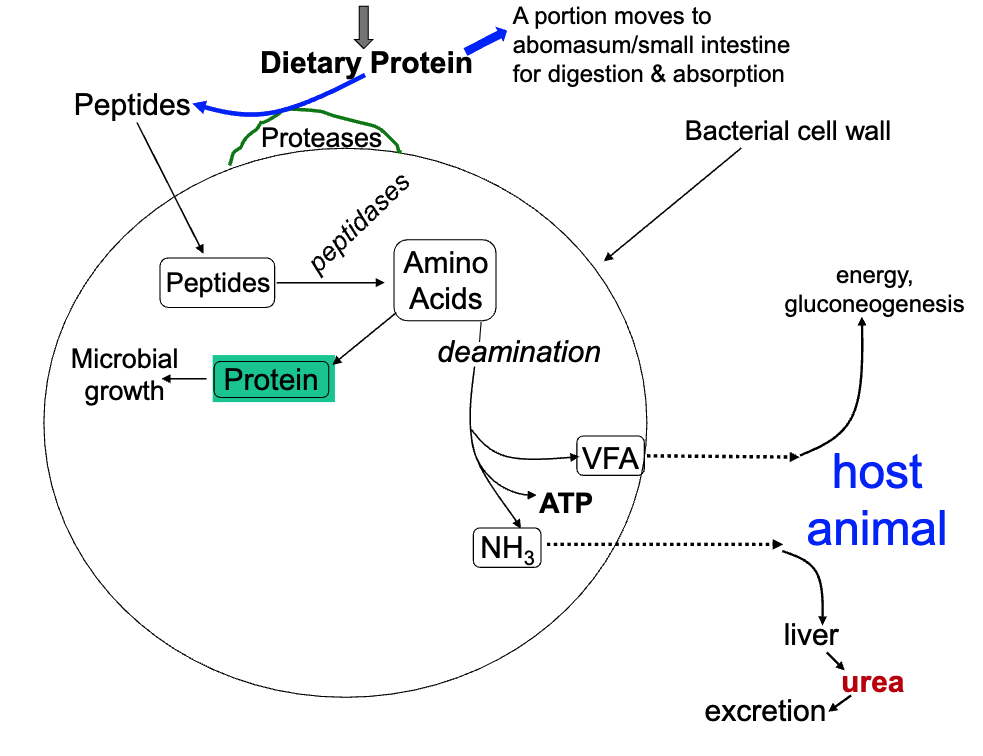
what are the possible fates for urea?
excreted by kidneys
“nitrogen recycling/urea nitrogen salvage”
urea circulating in blood diffuses back to rumen where it is broken down by urease (bacterial cell walls) and reused
some is taken up by salivary glands, secreted into saliva, and re-enters rumen after swallowing
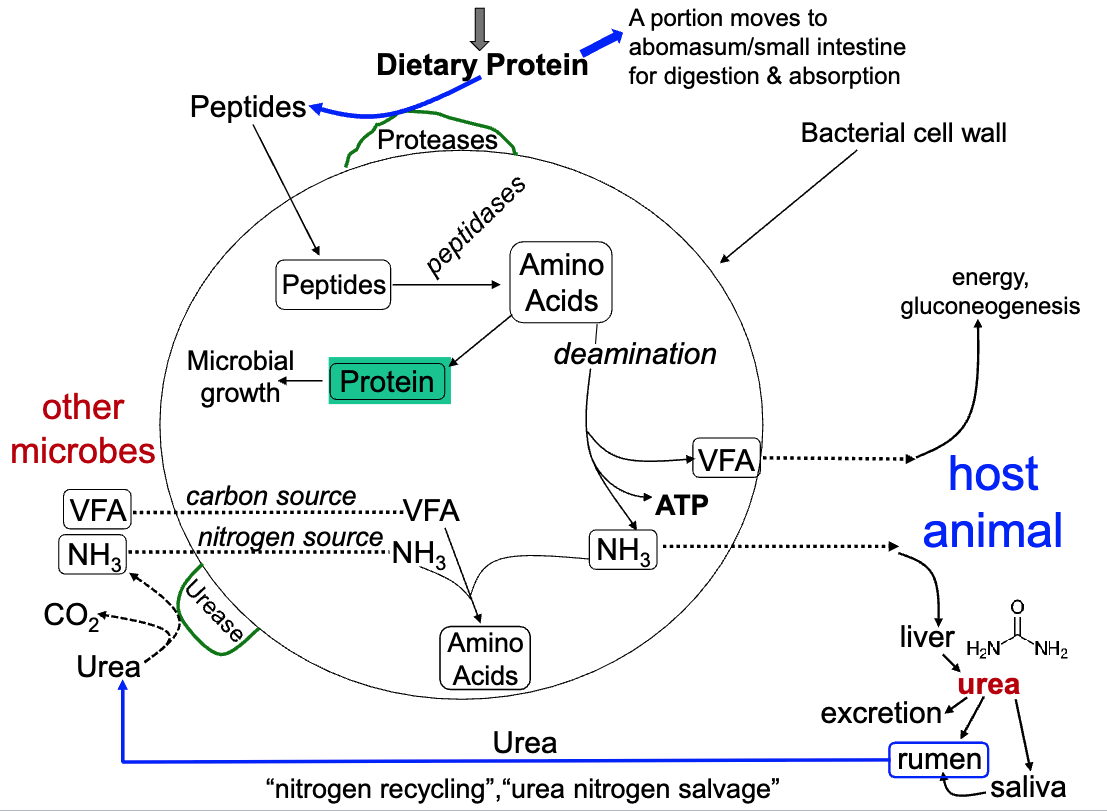
how is microbial protein digested in ruminants?
lysozymes secreted by the abomasal epithelial cells hydrolyze bacterial cell walls → optimized for low pH
releases amino acids & short peptides which can be absorbed in the small intestine

lipid digestion in ruminants
dietary triglycerides and phospholipids are hydrolyzed by microbes into fatty acids and glycerol
glycerol can be fermented into VFAs and used by animal
rumen microbes hydrogenate unsaturated fatty acids into saturated fatty acids → one way to dispose of H+ in rumen
medium, long-chain fatty acids are absorbed in the small intestine
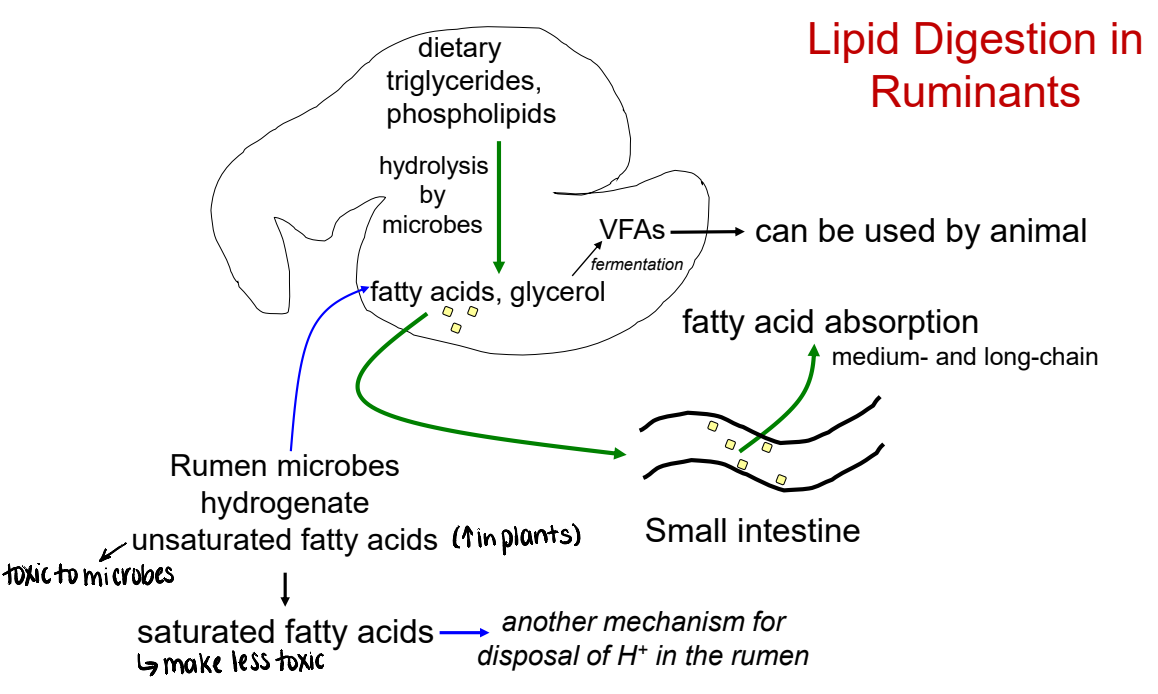
why do rumen microbes hydrogenate unsaturated fatty acids?
unsaturated fatty acids are toxic to microbes → saturated fatty acids are less toxic
how are volatile fatty acids absorbed in the rumen?
Na+-coupled transport
SMCT (monocarboxylate) transporter can transfer ionized form in with Na+
passive diffusion
add H+ to neutralize charge → can now diffuse across cell membrane
**note: Na+, Cl-, and H2O are absorbed with VFAs
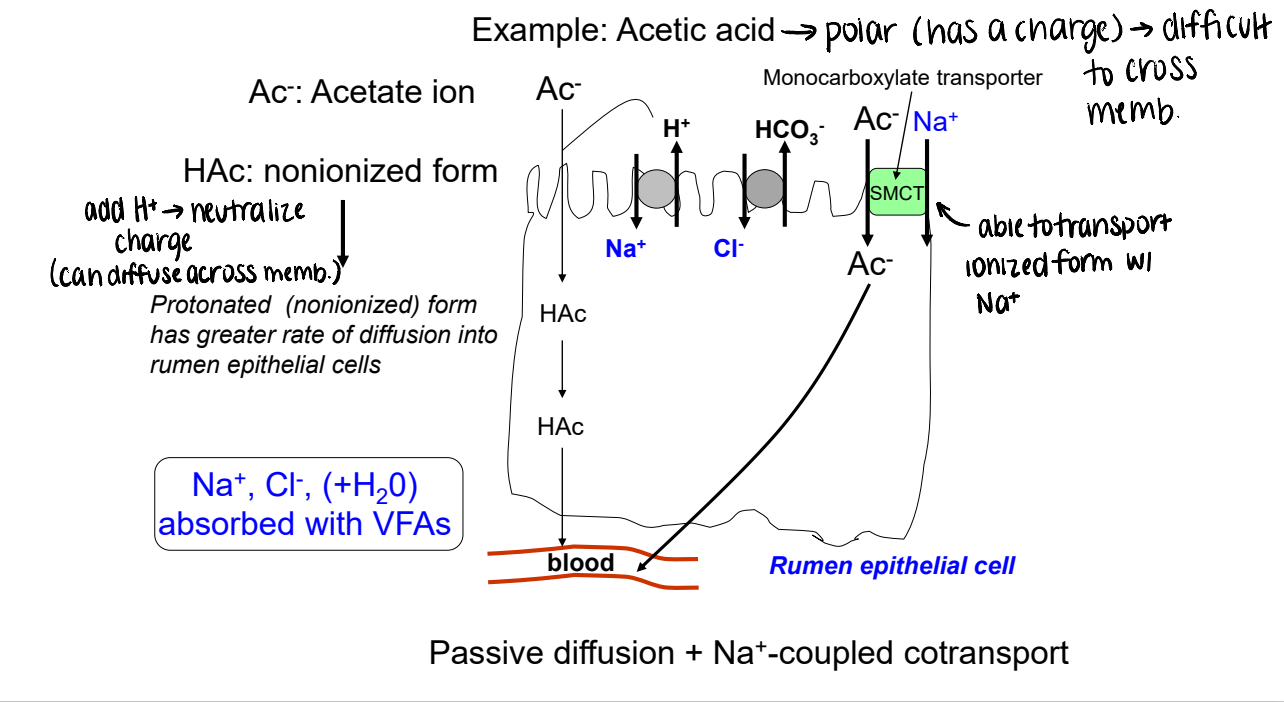
how is acetate utilized by the ruminant?
used for energy (ATP) throughout the body
converted to acetyl CoA → citric acid cycle
produced in greatest amounts
how is propionate utilized by the ruminant?
gluconeogenesis in liver or oxidized for energy (ATP)
gluconeogenesis important for milk production in lactating cows
how is butyrate utilized by the ruminant?
preferred fuel source for rumen epithelial cells (critical for rumen growth / development)
what is the function of primary contractions in the rumen?
mixing and particle separation
shuttles well-digested feed to omasum
starts in reticulum
most frequent type of contraction in rumen/reticulum
what are the functions of secondary contractions in the rumen?
enhances mixing of rumen contents
moves gas to cardia for eructation
starts from dorsal sac, not reticulum
what is the function of the cranial pillar in eructation?
cranial pillar holds back fluid/feed from entering the esophagus and prevents it from getting aspirated
bloat
distention of the rumen/reticulum caused by accumulated gas
results from prevention of eructation → gas trapped in stomach
what are the functions of the omasum?
some fermentation; remaining VFA absorption
filters out large particles for further breakdown; allows only fine particles to move into the abomasum
what are the functions of the abomasum?
secretes HCl, water, pepsin, lysozyme, chymosin (rennin) in neonates
regulates flow into the duodenum (gastric emptying)
stimulated by antral/pyloric distention
inhibited by duodenal distention, low duodenal pH
severe distention of the abomasum inhibits primary waves in rumen
what controls forestomach motility in ruminants?
vago-vagal reflexes: afferent and efferents via vagus nerve
motility center in medulla
motility is stimulated by fibrous feeds but inhibited by high concentrate diets
motility also inhibited by:
severe distension
pH < 5
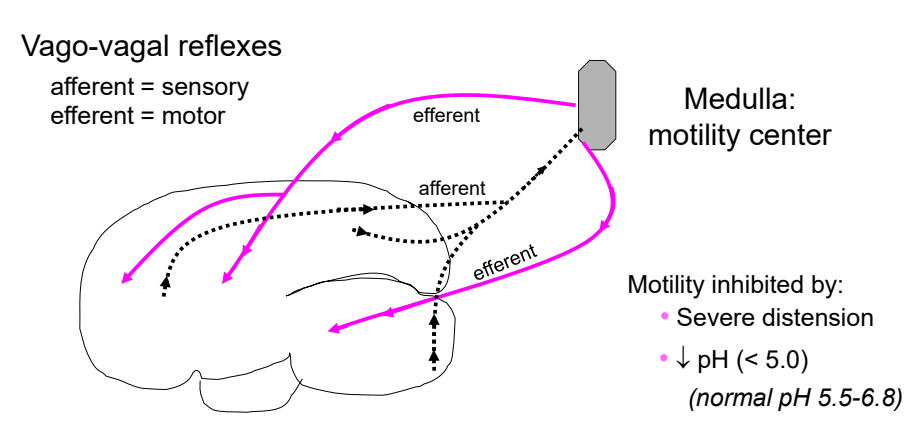
reticuluar groove
groove formed during suckling of neonates → allows milk to bypass the rumen/reticulum and go to abomasum
reflex initiated by tactile stimulation of the pharynx
how is rumen/microbial population development stimulated?
microbiota established during birth
microbial contaminants in milk
ingestion of contaminated feed, water
contact with feces, cud from adults
VFAs stimulate mucosal growth in forestomach, especially butyrate
solid feed (bulk) stimulates muscular growth and development of reflexes
what are the motility patterns in the cecum & colon of horses?
segmentation (mixing): promotes fermentation and short chain fatty acid absorption
propulsive peristalsis: moves ingesta distally
retropulsive peristalsis: moves ingesta orally; increases time for microbial fermentation and absorption of VFAs, water, and electrolytes
why do horses need to have higher quality dietary protein?
microbial protein in the hindgut is largely unavailable to the host, so equine diets must have more digestible protein than bovids
how is hindgut pH maintained (hingut fermenters)?
pancreatic and ileal secretions provide HCO3- and phosphate buffers to maintain pH at optimal levels during carbohydrate fermentation
additional HCO3- is secreted by hindgut epithelial cells (cecum, colon)
what is the function of the avian crop?
storage of food
similar to fundus of monogastric stomach
what is the function of the proventriculus?
glandular portion of stomach → secretes acid, pepsin
propels food into the ventriculus
analogous to the body of the monogastric stomach
what are the functions of the ventriculus (gizzard)?
maceration (mechanical breakdown), storage, propulsion of food into small intestine
analogous to antrum of monogastric stomach
how does the ventriculus differ in carnivores vs granivores?
carnivores: thin-walled, distensible; less need for mixing and grinding
granivores: highly muscular, non-distensible; high need for grinding of food